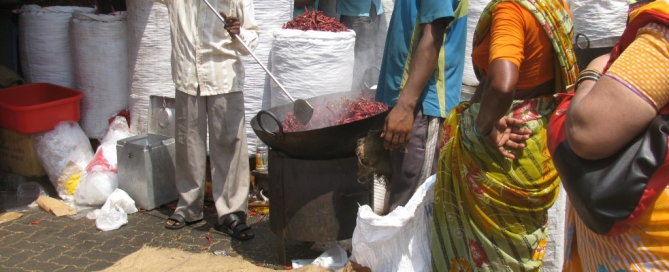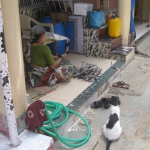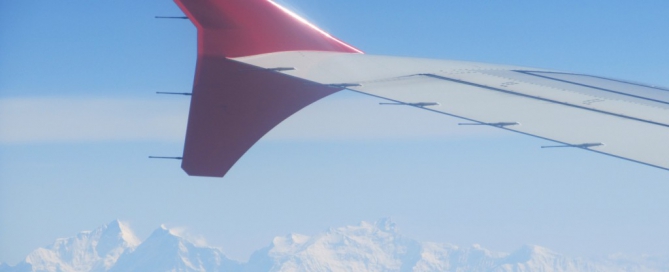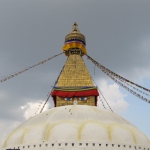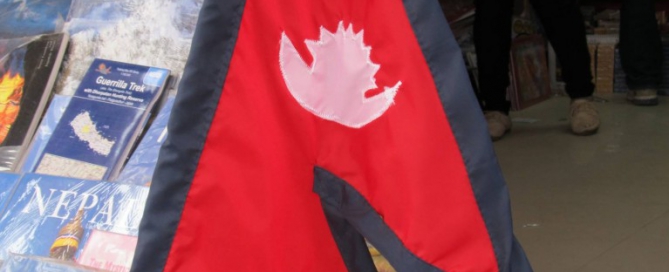Chillies and cricket from the centre of the earth
April is a hot time to visit Mumbai but Ramanand, my guide, showed me that Mumbaikers like their lives to be hot on the inside too. We wandered through Lalbag Masala Gully where I was surprised to see groups of ladies sitting in the shade with sacks laid out in front of them, piled high with red hot chillies. Some piles were large and Ram said this would belong to a bus load of ladies from a village, coming to the city to “stock up.” A girls’ day out, Indian style.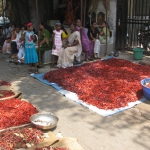
He explained they were waiting to have their own special combination of spices pounded into a year’s supply of “exclusive flavoured masala.” Basins full of peppercorns, cinnamon, cloves, cardamom and nutmeg lay beside them as they, and long lines of families, waited patiently for their turn to go forward.
Large woks sizzled with the chillies and the pungent aroma bombarded the senses, made my eyes smart and brought tears to my eyes! Barefoot men loaded the mixtures into machines which ground them down and filled plastic bags with the resulting powder.
April is clearly the month of the chilli, wherever we went they were drying in the sun. We moved on to visit the Sassoon docks and Koli village in Colaba. The 7 islands which make up modern Mumbai are the ancestral home of the Koli community, fishermen who fished as far away as Goa and Mangalore. Slowly their culture is dying and this was an opportunity to get a glimpse of their lives.
We arrived late in the morning so the main activity of the fish market was virtually over for the day with just a few latecomers unloading their fish. Ice was being emptied into the holds and fish thrown from man to man and finally on to the dockside. Ram interpreted for me as we chatted to a fisherman about the problems they encounter and how these mirror the reality in fishing communities in my home in the west coast of Scotland.
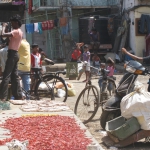 Exploring their village later Ram soon had a group of childrensurrounding him as he did bird impressions and magic and the innocent pleasure was a delight to see, no ipads or iphones in sight! Life is simple and uncomplicated, undoubtedly hard but there were genuine smiles and contentment that is sometimes missing in our commercialised western lives. A cat sat patiently watching a lady sorting fish, ever hopeful of a titbit.
Exploring their village later Ram soon had a group of childrensurrounding him as he did bird impressions and magic and the innocent pleasure was a delight to see, no ipads or iphones in sight! Life is simple and uncomplicated, undoubtedly hard but there were genuine smiles and contentment that is sometimes missing in our commercialised western lives. A cat sat patiently watching a lady sorting fish, ever hopeful of a titbit.
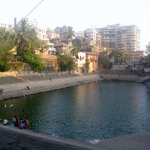
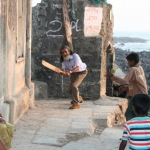 Ram and I ended our day at Banganga Tank on Malabar Hill, a quiet spot to watch the sun set over the sea. The ancient bathing tank is surrounded by Hindu temples and is a great spot to relax ..and chat with friends! It was first constructed in 1127 and the wooden pole in the middle of the tank is symbolic of the centre of the earth where Lord Rama’s arrow pierced it. We walked to the end of the road and the rocky foreshore was busy with groups of boys playing cricket, using tyres for stumps..or so it looked to a non cricketing aficionado like myself! Ram couldn’t resist joining in and soon the pied piper had done it again with a posse of kids trailing in his wake. Mumbai, a city of colour and people. Put on your walking shoes and enjoying experiencing the city. More than any other Indian city I have visited it is a place to go with the flow and people watch. While you are watching them…they will be watching you!
Ram and I ended our day at Banganga Tank on Malabar Hill, a quiet spot to watch the sun set over the sea. The ancient bathing tank is surrounded by Hindu temples and is a great spot to relax ..and chat with friends! It was first constructed in 1127 and the wooden pole in the middle of the tank is symbolic of the centre of the earth where Lord Rama’s arrow pierced it. We walked to the end of the road and the rocky foreshore was busy with groups of boys playing cricket, using tyres for stumps..or so it looked to a non cricketing aficionado like myself! Ram couldn’t resist joining in and soon the pied piper had done it again with a posse of kids trailing in his wake. Mumbai, a city of colour and people. Put on your walking shoes and enjoying experiencing the city. More than any other Indian city I have visited it is a place to go with the flow and people watch. While you are watching them…they will be watching you!

